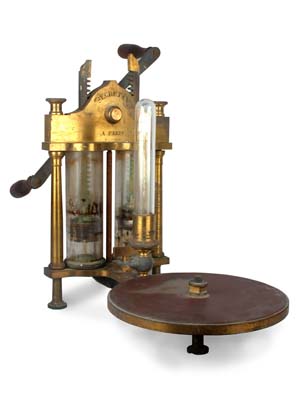Elective affinities: Valencia and the Chemical Revolution
|
Elective affinities:
Valencia and the Chemical Revolution(1780-1820)
From May 26 to October 30 2011
Palacio de Cerveró (Plaza de Cisneros, 4
- 46003, Valencia)
Exhibition hours: From Monday to Friday, from 9 to 20 h.
Saturday from 9 to 14h. and from 16 to 20
The building will be
closed from 8 to 21 August. |
|
IHMC-Palau de Cerveró [+] |
|

Laboratorio de Wilheim Carl Scheele (1742-1786), uno de
los potenciales descubridores del oxígeno.
|
| |
|
Organised by López Piñero History of Medicine and
Science Institute. Valencia University – Sociological
Research Centre, CSIC.
Venue: Palacio de Cerveró (Plaza de Cisneros, 4 - 46003,
Valencia)
Curator: José Ramón Bertomeu (Full Professor,
Universitat de València).
“Elective affinities: Valencia and the Chemical
Revolution”
In the section devoted to chemistry in the famous
Encyclopédie of the mid 18th century,
the “love for chemistry” was said to be “a
passion of the insane”. The article stated that
chemists were a not too numerous “different people”,
with a language and mysteries of their own, “almost
isolated” and surrounded by individuals who were “not
too curious about their activities”. This situation
changed substantially in the following years as
chemistry progressively entered universities, as was the
case with the Medical College of Valencia University.
Not only did the number of courses, lecturers and
students with an interest in chemistry rise. Strong
expectations also emerged as to the medical and
industrial prospects of this science. By the late 18th
century, novelties were so relevant that some authors
talked about a genuine “revolution in physics and
chemistry”. It was precisely then that the chemistry
professorship was created in the University of Valencia. |
| |
|
 Análisis
del arsénico. Soluciones y precipitaciones producidas
con diversos reactivos. Procedente de la obra de Jean L.
Lassaigne. Tratado completo de química… Madrid, Vda. de
calleja, 1844. Análisis
del arsénico. Soluciones y precipitaciones producidas
con diversos reactivos. Procedente de la obra de Jean L.
Lassaigne. Tratado completo de química… Madrid, Vda. de
calleja, 1844.
|

Máquina pneumática. Instituto de Educación Secundaria
Luis Vives de Valencia. |
| |
|
The exhibition “Elective affinities: Valencia and the
Chemical Revolution” explores this coincidence and
the development of modern chemistry in 18th
century Valencia. The exhibition is divided into two
sections. The first part shows the changes in European
chemistry at the end of the 18th century,
with events leading to the creation of the chemistry
professorship in Valencia, aimed at training physicians
and craftsmen. Historic examples allow us to critically
ponder about relevant issues in emerging chemistry at
the time, subjects which remain highly interesting today
and that might be of interest in the future too: the
relationship between science, technology and society,
the public image of chemistry, the circulation of
scientific and technological knowledge, the applications
of chemistry to industry and medicine, the role of
scientific instruments in experimental research, and the
links between science and economic and political power.
The second section is focused on the most renowned
chemical student of Valencia University: Mateu Orfila i
Rotger (1787-1853). Through his letters and mementoes,
his years as a student, his toxicological research and
his activity as an expert in some famous poisoning
crimes are recreated. Thanks to the excellent
collections of the University of Valencia and those
borrowed from other academic institutions, an exhibition
tour has been put together, one that includes numerous
visual elements, instruments, books and documentaries,
following a thread that is loyal to the most recent
historic investigations. An extensive side programme has
also been prepared, including related activities such as
a film cycle, a monographic issue of the magazine
Mètode, and an internet website with abundant
biographical information, a glossary of chemical terms,
and a digital library. All these resources will
contribute to increasing the level of information and to
making the most of the affinities –including elective
ones- that the exhibition seeks to boost in the
celebrations of 2011 as the international year of
chemistry. |
| |
|

Portada del manual de química de Pierre Macquer
(1718-1784). Detalle.
|
| |
|

Pierre Macquer (1718-1784). Tabla de elementos de
química teórica.
|
| |
|

“Retrato del matrimonio Lavoisier” David (1748-1825).
|
| |
|
|
|